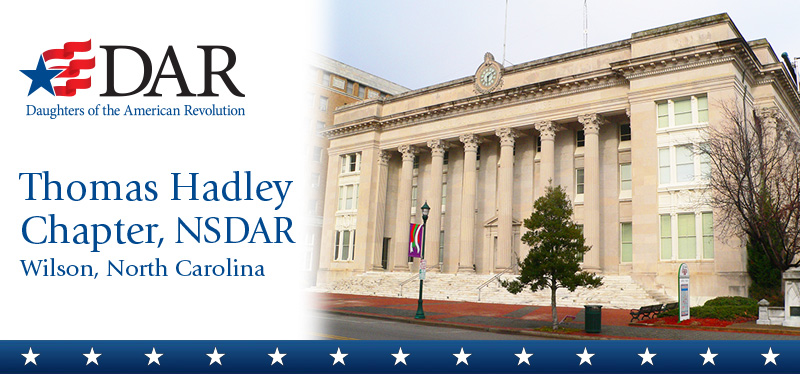
Historic Wilson County Courthouse photo from Wikimedia Commons, by Ammodramus (Own work, CC0)
History
Our chapter
The Thomas Hadley Chapter, NSDAR, was organized on September 1, 1922, in the home of Martitia Hadley Woodard, a large Victorian residence on the corner of Goldsboro and Lee Streets. She invited sixteen Wilson women who were members of DAR chapters in other towns or who were eligible for membership to meet Mary Graves Miles Kerr Spencer of Winston-Salem, the current North Carolina State Regent. Woodard had been appointed organizing Regent by Spencer. Ursula Daniel of Halifax, regent of the Elizabeth Montfort Ashe Chapter, NSDAR, was also present and claimed a mother’s privilege of naming the new chapter since members were leaving her chapter. She proposed it be called Thomas Hadley, who was the ancestor of six ladies present that day. In the Halifax Chapter, NSDAR, report for 1922 is the following: “In July 1922, seventeen members withdrew to organize the Thomas Hadley Chapter of Wilson, with Mrs. Walter F. Woodard, Organizing Regent.” Dues were set at $5 and Woodard promised that no assessment for any projects would be made, and no money raising projects undertaken. The meetings were scheduled for the first Saturday afternoon in each month.
Thomas Hadley
The first Hadley family came to America in 1712, settled in Pennsylvania, and later moved to Virginia. Thomas Hadley, son of Joshua Hadley and Mary Roland, was born in 1728 in the New Castle County, Delaware. He married Mary Thompson in 1750 and settled in the Cross Creek area, which is now Fayetteville. He was born, reared, and married among the Quakers, but he was an active American Revolutionary Patriot. In 1776, he was chosen to represent the town of Campbellton, which was named Fayetteville in 1784, at the North Carolina Provincial Congress which convened at Halifax, North Carolina on November 12. This was the fifth and last, as it was the most important, of the provincial conventions which inaugurated the Revolution in the colony of North Carolina and organized the government of the independent state. On December 18, the congress adopted the first Constitution of the State of North Carolina and two days later elected Richard Caswell governor. After his term in congress, Thomas Hadley entered the North Carolina Militia, served with credit, attained the rank of captain, and was killed by Tories on September 1, 1781. In October 1923, his and his wife’s remains were removed form Cumberland County by his descendants, the Woodards, as the grave sites were being lost. They were interned on the Hadley lot in the Maplewood Cemetery in Wilson and a granite monument placed at their graves. The inscription reads:
THOMAS HADLEY
BORN 1728 DIED SEPT. 1, 1781
MEMBER OF CONVENTION WHICH FRAMED THE
CONSTITUTION OF NORTH CAROLINA
1776
CAPTAIN IN NORTH CAROLINA MILITIA IN
AMERICAN REVOLUTION
FELL IN DEFENSE OF HIS COUNTRY’S
INDEPENDENCE
HIS WIFE
MARY THOMPSON
1730-1795
The content contained herein does not necessarily represent the position of the NSDAR. Web hyperlinks to
non-DAR sites are not the responsibility of the NSDAR, the state organizations, or individual DAR chapters.

